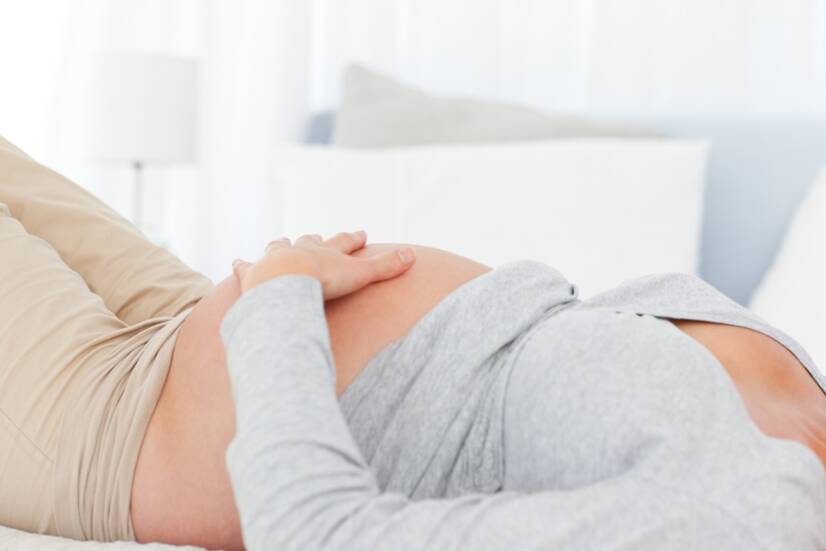- mayoclinic.org - Pregnancy week by week
- whattoexpect.com - 28 Weeks Pregnant
- thebump.com - Pregnancy Week by Week
Week 28: How does the 7th month of pregnancy begin? Changes in both woman and baby

You are starting your 7th month of pregnancy and the last of the 3rd trimester, which ends with the birth of your longed-for baby. How is your baby developing this week and what can you feel as your tummy grows?
Article content
You're starting your 7th month of pregnancy, the last of the 3rd trimester, which ends with the birth of the baby you want.
So let's read what your baby looks like and how it's developing.
Fetal development at 28 weeks
Your baby's body and face have already reached full development.
The head is more proportional to the body. By the end of the 28th week, his face has the appearance of an old man. His skin is still wrinkled due to the lack of fatty tissue, which accounts for only about 1% of its total weight.
What your baby looks like won't change much now. He will gain weight, replenish his fat tissue, and his face will smooth out and fill out.
It stores the fat it will need to maintain its body temperature after birth. The fetus is already beginning to partially regulate its body temperature. All the internal organs are maturing and preparing for the function needed after birth.
Its lungs and pulmonary vessels are still immature.
The brain is developing. It has been smooth, but the first folds and grooves are forming. Other tissues are also developing. Its brain and nervous system produce intermittent respiratory movements. Measured brain wave activity in a developing fetus at 28 weeks shows sleep cycles and rapid eye movements, which is the dreaming phase.
She may already be imagining what you'll look like. Just like you dream about what she'll be like and who she'll look like.
The first hairs are beginning to form on his head.
His eyes are already developed. Eyelashes are forming on his eyelids. Even though his eyes are developed and he opens them, he still can't see anything.
He is already controlling his facial movements, opening and closing his mouth, frowning. He is grasping his fingers and holding the umbilical cord, although he cannot see it yet.
The baby is already able to perceive pain. It reacts to external stimuli like a newborn.
He can distinguish between low and high pitched voices and his hearing is beginning to develop and improve.
He is tasting the amniotic fluid. He is beginning to perceive tastes. He is able to respond to different tastes such as bitter, sour, sweet. If you feel soft and regular muffled movements, a gentle periodic lifting of the tummy, your baby has probably drunk a lot of amniotic fluid and has hiccups.
The table shows the approximate measurements of the fetus at 28 weeks, taken with a sonographer
| overall length | weight | HC head circumference | BPD transverse head diameter | AC abdominal circumference | FL femur length |
| 37,6 cm | 1000 g | 260,4 mm | 73,5 mm | 233 mm | 51,3 mm |
Read more about fetal measurements in the article.
What can the mom-to-be feel?
You feel like you don't have enough room in your belly already. But the female body is evolved to cope with pregnancy and the subsequent growth of the tummy.
The first errands may start to come. They manifest as pain in the sacrum up to the abdomen, or as pain during menstruation. You may feel a hardening of the abdomen.
You become increasingly tired, have less energy.
The skin on your abdomen stretches and dries out. You may feel itchy. Stretch marks may start to form on your abdomen or on your hips, thighs and breasts. By regularly massaging your skin and moisturising with cream, you can partially avoid them.
Your food intake also decreases as the growing tummy and its pressure makes you feel full quickly. Heartburn also starts.
You may experience leg cramps, especially at night. You need to straighten your leg immediately and press your heel against the floor. The size of your abdomen will make it impossible to reach your toes and prevent you from pushing them towards you with your hands. Your legs may start to swell.
Your breasts are preparing to breastfeed through their next period of growth.
Walking up the stairs will make you short of breath. No wonder. Your tummy already has a weight that you carry with you all the time. Practice breathing exercises and try to relax.
Your gait may start to sway from hip extension, which can be painful. Wear comfortable shoes and try to avoid heels anymore.
Eat a healthy diet. It is recommended to increase calcium intake in your diet to strengthen the bones of the fetus.
Now is a great time for you and your partner to read books on baby care.
Antenatal preparation and examination?
You should start thinking about antenatal preparation and enrol in a course together with your partner. Preparation is important for your partner if he/she wants to be present at the birth of your baby.
A childbirth preparation course is a great help for the birth. It will explain to both of you the process of labour and different relaxation techniques. It will play you examples of births so that your partner also knows how labour works. This will prepare your partner for the second period of labour that you will go through together.
You will have the support of your partner with you during the birth, and they will also participate with you in the birth of your longed-for baby.
The visit to the counselling room is once every 3 weeks and once every 2 weeks for a high-risk pregnancy. Of course, the visit to the counselling room is determined by the doctor individually according to the condition of the mother.
In the consulting room, your blood pressure is measured, your urine is examined, your weight gain is recorded and swelling of the lower limbs is monitored. The doctor checks the growth of the uterus, monitors the cervix and the development of your baby, its heartbeat. He detects the intensity of movements and hardening of the abdomen.
If you haven't yet had an OGTT (oral glucose tolerance test), it's time. This is to find out if you have gestational diabetes, which is often asymptomatic in pregnant women. Babies of mothers with gestational diabetes are at risk for ill health and are often born weighing more than 4 kg.
How does the OGTT test work?
The OGTT test up to 28 weeks tests whether a woman's body is able to maintain normal blood glucose levels after a glucose load. Blood is taken fasting, then you drink diluted glucose dissolved in 250-300 ml of water or tea over 10 minutes.
Further finger prick blood draws are done after 60 and 120 minutes.
You must not eat during the test. The blood is taken to the laboratory and then the results are used to assess whether you have gestational diabetes.
Pre-eclampsia is also dangerous in pregnancy. It puts both the unborn child and the pregnant woman at risk.
Manifestations of pre-eclampsia:
- High blood pressure
- Fatigue
- headache
- nausea
- abdominal cramps
- visual impairment
- swelling
Inform your gynaecologist as soon as you notice risk symptoms.
Do you know what a solid pregnancy is?
We often encounter what is known as a solidarity pregnancy in the partners of pregnant women.
He may suffer from nausea, weight gain, swollen legs and other symptoms like his partner.
Premature babies
Babies born before the 28th week are referred to as extremely immature. After the 28th week until the 31st week as very immature, such babies account for about 10% of preterm births.
Thanks to advanced perinatology centres, premature babies have a good chance of survival.
Read more about the other weeks of pregnancy in this summary article:
Pregnancyby weeks: How does pregnancy and fetal development work?
Interesting resources
Related










